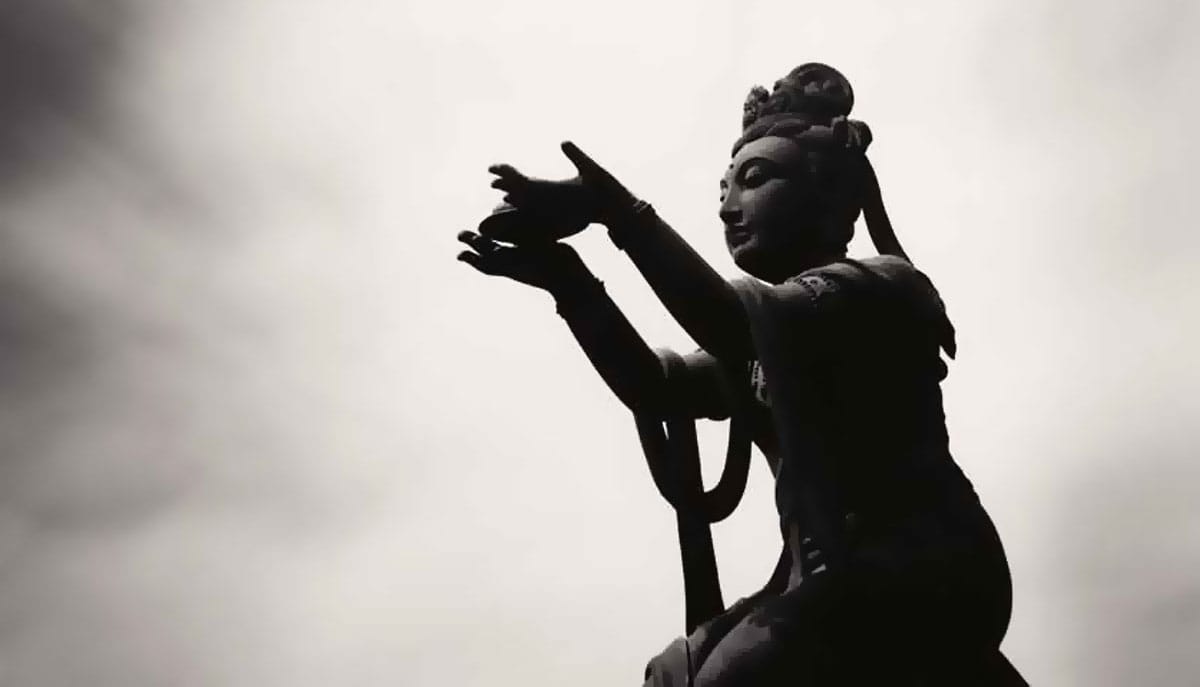I visit a lot of Buddhist temples and groups in North America, and it’s pretty common for people to ask, “So, what’s your practice?” It’s a sort of icebreaker in the Buddhist world. I think my answer tends to surprise some folks, though. As a Shin Buddhist, my primary practice isn’t meditation, sutra study, ritual, or precepts. All of these can be valuable, of course, but in Shin Buddhism our main focus is the practice of gratitude. This sets us apart from many other Buddhists. We don’t practice to achieve anything—not enlightenment, good karma, a favorable rebirth, or material rewards. We practice simply to give thanks for what we have received. It’s a small shift in one’s perspective, but when pursued, it can be transformative.
From the point of view of the dharma, we can see that each being exists within an inconceivable network of support from all things. Whether it’s the attainment of buddhahood or the simple act of drawing a breath, our every action is assisted by forces beyond the ego-self. As we become aware of our interconnectedness, we gain some perspective of our karmic limitations. Accomplishments we counted as our own successes turn out to be due to the myriad benefits received from others. Pulling on our bootstraps, we discover that someone else made the boots and the straps, and fed and nurtured us until we were ready to pull. Our own efforts are imperfect and cannot succeed unless countless others are involved. This awareness gives rise to a sense of humility about our limitations and patience in the face of others’ imperfections. It also cultivates a sense of humor about our shortcomings and those of others.
In Shin Buddhism, we don’t practice to achieve anything—not enlightenment, good karma, a favorable rebirth, or material rewards. We practice simply to give thanks for what we have received.
For Shin Buddhists, being aware of our interconnectedness involves being aware of how power-beyond-self is always nurturing and supporting us. Part of the Pure Land tradition, Shin Buddhists believe this power that comes from beyond the ego-self is provided by Amida Buddha, the limitless compassion and wisdom that benefits us all. Naturally, thankfulness wells up inside of us as we awaken to this ever-present gift.
With this awareness, Shin Buddhists say the nembutsu in gratitude. The nembutsu is a phrase, Namu Amida Butsu, that expresses our happiness and thankfulness. It isn’t a mantra or a prayer—it doesn’t accomplish anything other than letting out that bottled-up gratitude in a joyful utterance. When we say Namu Amida Butsu, we aren’t begging to get into the Pure Land or trying to win favors with the Buddha. We are saying, “How wonderful to receive so bountifully! Thank you very much!” I find that Buddhists in lineages other than the Pure Land schools often misunderstand this point.
Saying the nembutsu is just the most visible edge of a grateful life. On a deeper level, our practice is to respond thankfully in all areas of our lives. Every day brings innumerable gifts— life, love, nourishment, shelter, challenges, friendship, and more—and is an opportunity to recall our indebtedness as we reflect within ourselves. On a basic level, we try to remember the presence of power-beyond-self in our lives, say the nembutsu, and do our best to give back by being patient, helpful, and caring.
This practice of gratitude traces back about eight hundred years to premodern Japan and a Japanese monk named Shinran, who founded a new Buddhist school with his wife, Eshinni. After spending twenty years at Mt. Hiei, the center of Buddhist studies of that era in Japan, Shinran came to the insight that meditation, precepts, and other rigorous practices often subtly reinforce our egos. He saw that if we become good at sitting still for long periods of time, we may start thinking, “Wow, I’m a great meditator. Too bad all the other people out there don’t have my capacity.” Likewise, he saw that a glimpse of emptiness often leads us to believe that we are more enlightened than normal people, and that if we manage to adhere to strict precepts, we tend to slip into thinking, “I’m a good person, and people who don’t stick to the precepts are bad.” Indeed, Shinran found these sorts of attitudes in himself, and in his fellow monks as well. I know that I’m guilty of this, too.
Shinran concluded that very few of the monks he encountered, if any, were reaching levels of attainment akin to those described in the sutras. Furthermore, he felt that the exclusivity of monastic practice left behind those most in need of freedom from suffering. If Buddhist practice so often reinforced self-attachment and created divisions among people, even as practitioners believed they were making spiritual progress, then the only solution, according to Shinran, was to abandon the traditional practices altogether. Turning away from self-power, the notion that one can achieve realization through one’s own efforts, Shinran looked to power-beyond-self, taking refuge in Amida Buddha.
For Shinran, Amida Buddha was the embodiment of power-beyond-self. In the hundreds of Mahayana sutras discussing Amida and his Pure Land, he is described as infinite light and life (the meaning of Amitabha and Amitayus, the Sanskrit forms of his name), which represent unlimited wisdom and compassion. Pure Land motifs and practices are part of virtually all Mahayana schools of Buddhism, in Tibet, China, and elsewhere; every day, Tibetan lamas visualize Amida Buddha, Zen monks chant his name during funerals, and Fo Guang Shan nuns in Taiwan seek to create his Pure Land here in this life. In Japan, these teachings became the basis of several distinct Buddhist sects, included those founded by Shinran and his teacher, Honen.
The nembutsu isn’t a mantra or a prayer—it doesn’t accomplish anything other than letting out our bottled-up gratitude in a joyful utterance.
Shinran taught that Amida is the Buddha in his dharmakaya form—his ultimate, liberated nature—and that the Pure Land is a poetic description of nirvana. Putting the insights of Mahayana Buddhism into a narrative format, he described how Amida vowed to embrace all beings, no matter how bad or good, and liberate them from their greed and delusion. According to the stories contained in the sutras, this liberation for all is something that Amida accomplished ten kalpas ago—a time so ancient it is almost beyond reckoning. Shinran advanced his interpretation further, stating that “Amida seems to be a Buddha more ancient than kalpas as countless as the atoms of the universe.” This meant that Amida’s “vow” transcended history altogether and was thus timelessly true.
Shinran understood Amida as buddhanature. As he puts it, “Buddhanature is none other than Tathagata [Buddha]. This Tathagata pervades the countless worlds; it fills the hearts and minds of the ocean of all beings. Thus, plants, trees, and land all attain buddhahood.”
Liberation is therefore always naturally available and needn’t be chased after endlessly. Shinran taught that we must give up attachment to our ego-laden efforts to become enlightened and relax back into the embrace of inconceivable wisdom and never-abandoning compassion. In this way, we are freed from our anxieties and pettiness. Our practice, then, stops being about attaining buddhahood for ourselves and instead becomes about expressing gratitude for all that we have received. This is a way of life that deepens as the years pass; as Shinran put it, “My joy grows even fuller, my gratitude and indebtedness ever more compelling.” Buddhist practice is transformed into an act of pure expressiveness that puts our inner feelings into word and deed through the utterance of the nembutsu and other acts of gratitude.
Other Pure Land Buddhist masters, including Shinran’s own beloved teacher, Honen, stressed the importance of anticipating the last moment of one’s life, when Amida would rescue us from our sorrows and take us to be reborn in the Pure Land. In contrast, Shinran’s interpretation was that by having a trusting heart, we experience the joy that accompanies birth in the Pure Land during this life, rather than waiting anxiously for liberation in the future. When the end of life does arrive, our karmic entanglements are unraveled as we are released into the bliss of the Pure Land, the realm of nirvana. However, Shinran’s vision of the Pure Land is far from a heavenly resting place. Instead, he taught that we immediately return in innumerable forms to free those still trapped in suffering, eternally working on behalf of others.
Pure Land teachings electrified medieval Japan, leading to popularity as well as persecution. Seen as a threat to the establishment, Honen and a group of his students, including Shinran, were stripped of their Buddhist credentials and exiled from Kyoto for several years. But Shin-ran never ceased teaching, and after his death his daughter founded a temple in his memory, which eventually led to the development of the Shin school of Pure Land Buddhism. Over time, it grew to have an enormous impact on Japanese society. Much of its appeal came from the fact that anyone could be involved, even people who were traditionally excluded from advanced Buddhist practice, such as women, peasants, fishermen, hunters, soldiers, outcasts, prostitutes, and others who were not allowed in the monasteries.
For those who can’t seem to master meditation, or have trouble perfecting strict precepts, or are looking for a Buddhist path that says, ‘Just as you are, you are affirmed and included,’ Shin Buddhism is still here offering an ancient tradition designed to help them in their lives.
Today, Shin is the form of Buddhism with by far the most adherents in Japan, the second largest being Jodo Shu, the Pure Land school founded by Shinran’s teacher, Honen. In the late 1800s, Shin Buddhism came to Hawaii and North America, and today there are more than a hundred temples, many of them more than a century old, in the United States and Canada. Their members include people who are now fourth- and fifth-generation Western Buddhists. During that long North American history, they have often been at the forefront of developments in American Buddhism—making Buddhist arguments for labor rights, giving Gary Snyder and Jack Kerouac their first taste of living Buddhism, founding the first Buddhist seminary in the West, performing the first Buddhist same-sex marriages, developing the first Buddhist prison ministries, and innovating other forms of what has come to be called engaged Buddhism.
A lot has changed since those early Buddhist pioneers brought the dharma to our shores. It’s wonderful how many Buddhist options there are for people in the West these days, everything from intense three-year retreats to mindfulness practice for dealing with everyday stress. But for those who can’t seem to master meditation, or have trouble perfecting strict precepts, or are looking for a Buddhist path that says, “Just as you are, you are affirmed and included,” Shin Buddhism is still here offering an ancient tradition designed to help them in their lives. Regardless of what path an individual decides to take, Shin Buddhists believe we will all be born together in the Pure Land—liberation—and become bodhisattvas who work to care for all suffering beings. It’s a path designed for the ordinary foolish being like myself—and perhaps that is what I’m most grateful for of all.


